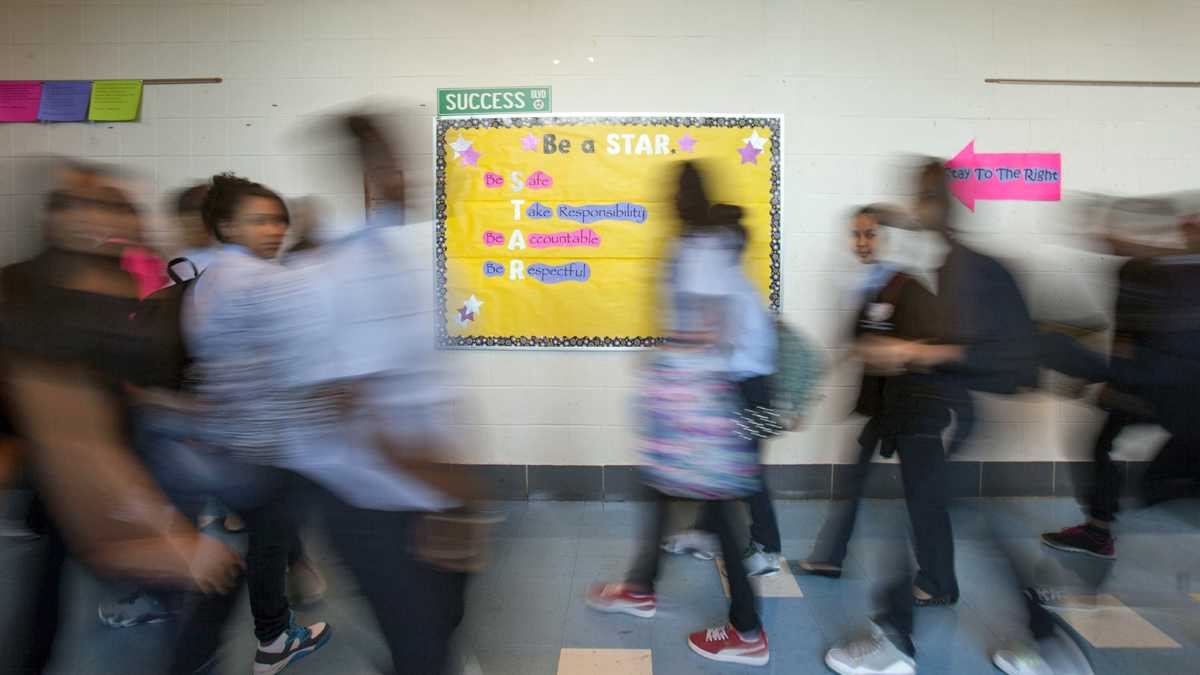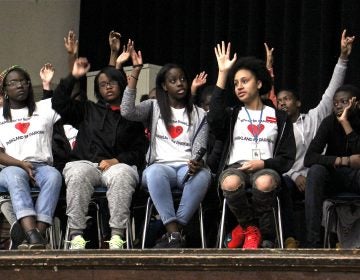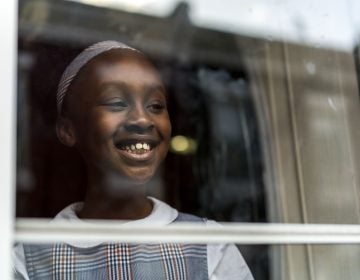Juvenile court judges waking up to trauma’s effect on kids

Middle school students change classes in Philadelphia. (Jessica Kourkounis/WHYY)
If one is looking for the most traumatized youths in Philadelphia, a good starting place might be the courtroom that houses the Working to Restore Adolescents’ Power (WRAP) program.
It’s designed for juvenile victims of sex trafficking who have also been charged with crimes.
Until about a year ago, the program was run by Judge Lori Dumas, who would sit with each defendant for face-to-face meetings to build trust. An interdisciplinary team that also includes a prosecutor, defense counsel, and treatment providers work together to avert criminal proceedings in all but the most serious cases.
The program helped Dumas win the first Innovator of the Year Award from the National Council of Juvenile and Family Court Judges.
But outside the WRAP courtroom, she has a larger goal: making Philadelphia’s judges more sensitive to the role of trauma as a key element in youth crime and delinquency.
At times, it can seem like an uphill battle.
“The leadership is not very responsive to outside opinions,” she says. “That’s the nicest way I can put it. Individual judges have made adjustments.
“I’ve been trying to beat down the doors for more training.”
Recently, the doors seem to be opening a crack.
Several judges attended an Oct. 30 conference on juvenile justice where Kamilah Jackson of Community Behavioral Health in Philadelphia and Timene Farlow, deputy commissioner of the city’s Department of Human Services, made a presentation on “Trauma and the Juvenile Justice Population.”
And sometime next year, all court personnel will take a course on trauma and its effects that was designed by a team headed by Sandra Bloom, a Drexel University professor who is recognized internationally as an authority on the subject.
Sheila Woods-Skipper, outgoing president judge of the Philadelphia Court of Common Pleas, says that the goal is “to ensure that everyone is aware of trauma that may be impacting them or others…and resources they can tap to deal with it…The goal is to be inclusive.”
An ‘aha’ moment in Ohio
The youth standing before family Court Judge Michael Howard in Stark County, Ohio, had achieved almost perfect attendance during his school career.
Now, he was skipping school repeatedly, and Howard was preparing to launch into his standard truancy speech when something stopped him.
“I was just sensing something wasn’t right,” Howard recalled about the case from about a decade ago. “All of a sudden he just goes in the tank?”
He ordered further investigation, and it turned out that something was, indeed, very wrong. The young man’s truancy started right after his mother’s boyfriend shot her to death as he looked on.
“It was an ‘aha’ moment,” said Howard, now retired but in the forefront of a movement to reform the juvenile justice system across the country.
Authorities estimate that more than 90 percent of youths in the system have experienced at least one traumatic incident in their lives.
“The key is understanding these kids are victims as well,” said Isaiah Pickens, a clinical psychologist who provides trauma-informed training to juvenile justice agencies around the country.
This training seeks to shift the focus of attention on children who have behavior issues from “what is wrong with you?” to “what happened to you?”
But unlike teachers and social workers, judges have responsibility for community safety, so considerations of trauma can often take a back seat.
“The first thing the judge thinks is, ‘What is this person charged with?’ ” Howard said.
“I’ve done trainings where judges have pushed back pretty hard. They say the only thing that works is locking somebody up,” he said.
“We’re trying to change behavior, and we have to address the trauma,” Howard tells them. “It doesn’t mean they get a free ride.”
Trauma training for judges
For judges who are interested in creating trauma-informed courtrooms, educational opportunities have grown greatly in recent years.
The National Child Traumatic Stress Network has developed a self-evaluation tool for court systems that is now undergoing beta testing. At the state level, the Administrative Office of Pennsylvania Courts has expanded its offerings about trauma as part of its continuing judicial training program.
Stephen Feiler, the office’s director of education, said that although these courses are electives, he has found judges – and particularly younger judges – increasingly likely to choose them.
“The demographics of the bench,” he said, “are changing.”
In recent years, Howard, whose court was based in Canton, Ohio, has worked closely with the National Child Traumatic Stress Network, based at UCLA and Duke University, which has developed extensive guides and training materials for juvenile court judges.
Another Ohio judge, Linda Teodosio of Juvenile Court in Summit County, which includes Akron, has won wide recognition for innovations that intentionally blur the line between social work and criminal justice. These have included the New Paths program for families of children with developmental disabilities, and the Crossroads Program, which deals with youth who have substance-abuse and mental health issues.
Conceding that she is “a judge, not a therapist,” Teodosio nonetheless said that “It’s up to the court to figure out what’s causing [delinquent] behavior.”
She regularly visits facilities where youth are placed because of delinquency or need of safety and estimates that the court works with 45 social service and related agencies throughout the county.
The Model Courts project
“I’m a very different judge from what I was at the beginning,” said Judge Kim Berkeley Clark, who joined the Allegheny County, Pa., Family Court bench almost 20 years ago.
A former prosecutor of homicide cases in which a juvenile was being tried as an adult, Clark said that at first, she tended to lecture defendants.
Not anymore, she said, because “it’s totally ineffective.” She now sees her job as being more about listening than about preaching.
Allegheny County is one of more than 140 U.S. courts enrolled in the Model Courts project of the National Council of Juvenile and Family Court Judges. The project provides technical assistance and individualized assessments in hopes of making the courts “laboratories for change.”
One of Allegheny County’s key goals in the program is to deal with an unpleasant reality of the juvenile justice system nationwide: For youth who are suffering from trauma, the courtroom can make things worse.
Using focus groups, surveys of families and children who had been in court, and training of court personnel, Clark tries to “make sure we don’t retraumatize people.”
As she and other juvenile court judges point out, children in the juvenile system often have parents who have not only been traumatized themselves, but have also had their own bad experiences with the court system.
Instead of having all defendants and their families show up at 9 a.m., Clark has gone to staggered hearings and block scheduling.
“As they sit and wait, the trauma increases,” she said. “When they get into the courtroom, they’re a mess.”
As simple as it sounds, she said that another problem is people not understanding how the system works and not feeling as if they’ve been heard.
“It doesn’t matter if that perception isn’t accurate,” she said. “It’s their reality.”
The court has also had probation officers trained in “motivational interviewing,” a technique of asking open-ended questions to help youths share their issues and perhaps develop a positive narrative of where their life might be headed.
Two examples she cites: “What are your strengths?” and “What’s going to be a challenge for you when you go home?”
Optimistic signs in Philadelphia
Leola Hardy, chief of the juvenile unit at the Defender Association of Philadelphia, says it is critical that judges be trauma-informed: “They’re the ones who decide what happens to the kid.”
Right now, she says, “The court isn’t as well-informed as it might be.”
Walter Olszewski, supervising judge of the Family Division of Philadelphia Court of Common Pleas, declined to be interviewed on this topic.
Hardy and another attorney with the division, Ellyn Sapper, express some optimism about the system becoming more trauma-informed.
They say that one encouraging sign was Philadelphia District Attorney Larry Krasner’s appointment of Robert Listenbee, Jr., formerly chief of the juvenile unit of the Defender Association of Philadelphia, as his first assistant.
“I think the pendulum is moving in that direction,” says Sapper. “But it’s still baby steps.”
Correction: A prior version of this story implied that Judge Dumas still presides over the WRAP program.
WHYY is your source for fact-based, in-depth journalism and information. As a nonprofit organization, we rely on financial support from readers like you. Please give today.





